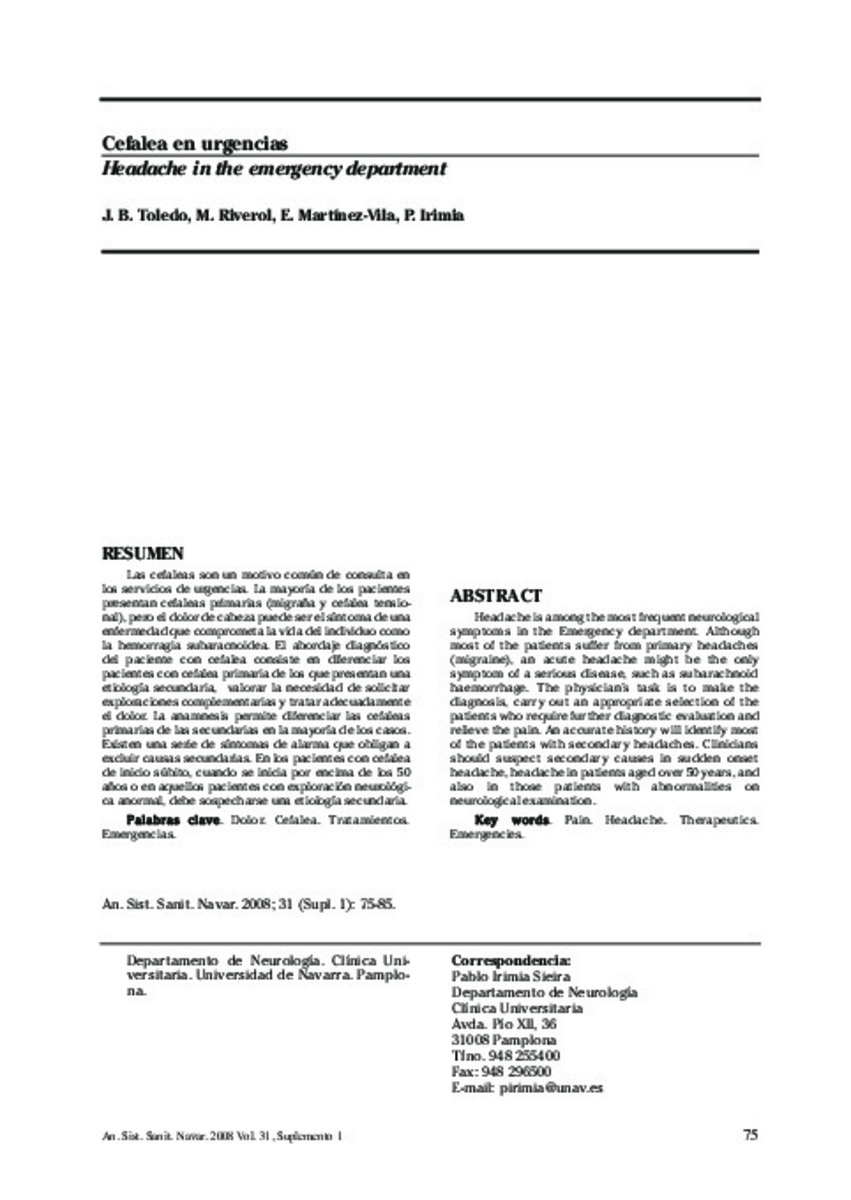Full metadata record
| DC Field | Value | Language |
|---|---|---|
| dc.creator | Toledo, J.B. (J.B.) | - |
| dc.creator | Riverol, M. (Mario) | - |
| dc.creator | Martinez-Vila, E. (Eduardo) | - |
| dc.creator | Irimia, P. (Pablo) | - |
| dc.date.accessioned | 2012-06-18T15:48:41Z | - |
| dc.date.available | 2012-06-18T15:48:41Z | - |
| dc.date.issued | 2008 | - |
| dc.identifier.citation | Toledo JB, Riverol M, Martinez-Vila E, Irimia P. Cefalea en urgencias. An Sist Sanit Navar 2008;31 Suppl 1:75-85. | es_ES |
| dc.identifier.issn | 1137-6627 | - |
| dc.identifier.uri | https://hdl.handle.net/10171/22602 | - |
| dc.description.abstract | Headache is among the most frequent neurological symptoms in the Emergency department. Although most of the patients suffer from primary headaches (migraine), an acute headache might be the only symptom of a serious disease, such as subarachnoid haemorrhage. The physician’s task is to make the diagnosis, carry out an appropriate selection of the patients who require further diagnostic evaluation and relieve the pain. An accurate history will identify most of the patients with secondary headaches. Clinicians should suspect secondary causes in sudden onset headache, headache in patients aged over 50 years, and also in those patients with abnormalities on neurological examination. | es_ES |
| dc.language.iso | spa | es_ES |
| dc.publisher | Gobierno de Navarra. Departamento de Salud | es_ES |
| dc.rights | info:eu-repo/semantics/openAccess | es_ES |
| dc.subject | Pain | es_ES |
| dc.subject | Headache | es_ES |
| dc.subject | Therapeutics | es_ES |
| dc.title | Cefalea en urgencias | es_ES |
| dc.title.alternative | Headache in the emergency department | es_ES |
| dc.type | info:eu-repo/semantics/article | es_ES |
| dc.relation.publisherversion | http://www.cfnavarra.es/SALUD/ANALES/textos/Vol31/sup1/PDFs%20ALTA%20CALIDAD/06_Cefalea%20en%20urgencias.pdf | es_ES |
| dc.type.driver | info:eu-repo/semantics/article | es_ES |
Files in This Item:
Statistics and impact
Items in Dadun are protected by copyright, with all rights reserved, unless otherwise indicated.






